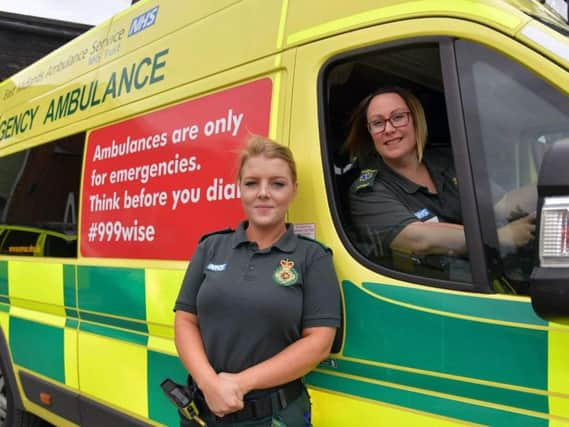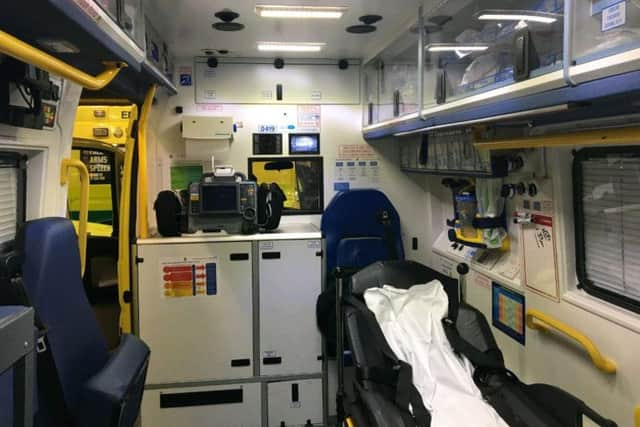FEATURE: Is waiting longer for an ambulance a good thing? Reporter Carly Roberts goes out on a shift in Northampton


I was with the East Midlands Ambulance Service trying to ascertain whether new Government response time targets were, as promised, getting paramedics to life-threatening emergencies quicker.
Our first port-of-call was to aid a disgruntled 76-year-old - wearing nothing much more than a white singlet - in Northampton. He was perched on his bed in a 1970s-style bedroom-cum-dining room, wincing from leg ulcers. He was referred to hospital by his GP, after his wife made a call for him the night before, and waited overnight for a crew to take him to A&E.
Advertisement
Hide AdAdvertisement
Hide AdThis is the offshoot of targets in action. Non-emergency patients can expect to wait (even) longer as medical priorities are juggled.


“It can become quite a difficult situation for patients when an ambulance doesn’t arrive because somebody else’s heart has stopped beating,” said Nichola Frost, who has been a qualified paramedic in Northampton for three years.
It became apparent, that what might be a ‘emergency’ situation to one family, might not be on the top of the list for paramedics.
“People dialling 999 for an ambulance have different anxiety and fears for a loved one - in what is deemed an emergency - but it’s about ensuring the right response is dispatched for the right emergency, allowing the best possible care for the individual in need,” Nichola adds.
Advertisement
Hide AdAdvertisement
Hide AdThe NHS says, in most 999 calls the authority knows the best clinical outcome for patients is not about the fastest response by the nearest vehicle, but the most appropriate one.


It’s anticipated that an ambulance crew will attend about six or seven jobs per day.
Those patients could be anything from unresponsive, struggling to breathe or yelping from broken bones. Similar to what I saw, while I was on duty with Nichola and technician, Hannah Lockhart-Cole, who were based from Northampton North Ambulance station that day.
Although we saw somewhat uneventful jobs that day, I take my hat off to the ambulance staff’s persistent strength of character.
Advertisement
Hide AdAdvertisement
Hide AdNichola, told me that she loves the social aspect of her job but it comes with its difficulties, too.“One of the hardest things is explaining to the family that a loved one has died, it’s awful.”
“I’ve been qualified for nearly three years and I learn something new every day.”
Shane Reeves, 39, of Billing Road was our next call out and was somewhat more urgent. He was discharged from hospital overnight following clear chest x-rays, but was soon readmitted to Northampton General Hospital after complaining of a tight chest and bad asthma.
A high-risk patient, we got there quickly and within minutes Nichola and Hannah were checking him over.
Advertisement
Hide AdAdvertisement
Hide AdShane’s chest was probably not made any better by smoking 60 cigarettes a day, his pal said, while he was also smoking, perched against an open window.
After ambulance staff quickly warned the friend that the oxygen tank is explosive around burning ash, thankfully, he soon stubbed it out before Shane was taken to A&E.
Just these two jobs show how the response times are starting to have an impact. Arguably, it might have taken longer to get to someone like Shane if medics had been forced to attend the pensioner with the leg ulcers within 20 minutes.
“Calls are better prioritised, and as a result, appropriate response times are improving,” Nichola says.
Advertisement
Hide AdAdvertisement
Hide AdNo doubt patients and their families will take time to accept the fact they will have even lengthier waits for non-urgent - although often painful and distressing - ailments.
But with money at an all-time low, speeding stretched medics more quickly to where they can save lives surely makes sense.